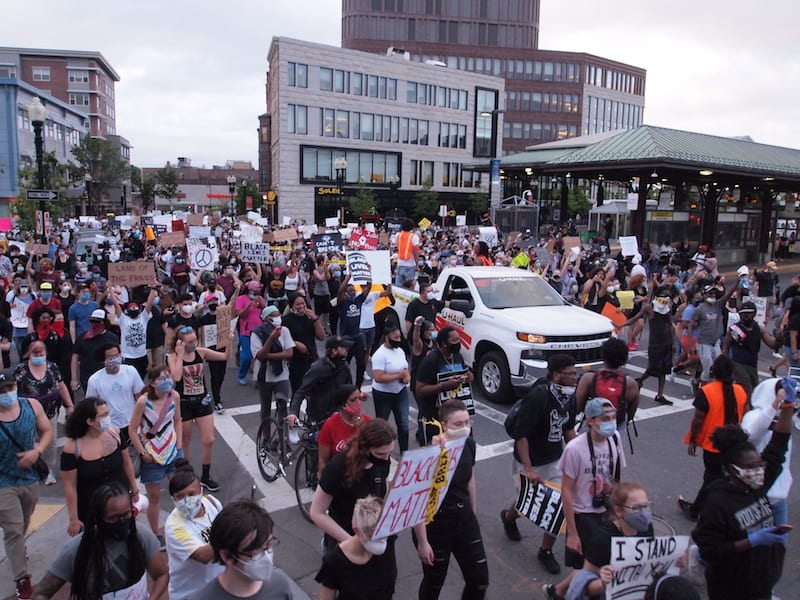Anti-police violence protesters take to the streets
Demonstrations in U.S. Boston, other U.S. cities turn violent

At the beginning of last week, news of the May 25 Minneapolis police killing of George Floyd dominated headlines as black America came to grips with the latest in a string of video-recorded violence. By the end of the week, it was the widespread police violence against protestors, journalists and sometimes bystanders that captured the attention of the media.
Sunday, the wave of violence hit Boston, when protestors leaving a gathering at the State House fanned out into Downtown Crossing, some smashing store windows and throwing rocks and water bottles at police officers. A police car was set ablaze and some stores were looted. Police responded with tear gas and stun grenades in some areas. The National Guard was called in by 11 p.m. as the looting extended into Newbury Street and the Copley Square area.
The demonstrations in Boston and around the U.S. came after Minneapolis police fired officer Derek Chauvin who kneeled on Floyd’s neck, suffocating him, and three officers who stood by and did not intervene in the killing. While criminal charges were brought against Chauvin within days — an unprecedented pace for a police killing in the United States — it was already too late to calm the conflagration of protests from people who are frustrated after six years of Black Lives Matter demonstrations and little apparent change in police attitudes toward the black men and women who continue to die at their hands.
That frustration was on display last week when demonstrators forced their way into a Minneapolis police precinct and set the building on fire. Footage of the police building engulfed in flames spread on social media and served as a Rorschach test for Americans. Donald Trump on Twitter referenced a segregation-era Miami sheriff’s words, “when the looting starts, the shooting starts,” raising charges he is fanning the flames of racial tension and emboldening trigger-happy police officers.

Youth protesters lead a march on Sunday.
Banner photo
For some, the sight of the burning precinct sent a message of a popular uprising in blacks’ decades-long struggle against police brutality and malfeasance.
“It’s not seeing the flames. It’s not imagining the smell of the fire. It’s hearing people cheering on the news that gave me goosebumps,” said one demonstrator during the protest Friday.
For police officers who have responded to the last six years of demonstrations with the same paramilitary tactics, tear gas, and rubber-coated steel bullets used on protesters in the streets of Hong Kong and in Palestine, the sight of the burning precinct seemed to elicit a more violent response to the anti-police violence demonstrators.
While officers in Boston made arrests and used tear gas, the level of violence in Boston seemed tame compared to other U.S. cities.
In Minneapolis, one journalist lost an eye after an officer fired a rubber-coated steel projectile at her face. In Louisville, Kentucky, a police officer appeared to take aim at a journalist before striking her in the eye with a pepper ball on live television. In addition to being targeted with non-lethal weapons, journalists have been arrested while recording police.
In New York City, video footage showed police cruisers ramming demonstrators with their cruisers, pushing through a crowd that blocked an intersection. In Sacramento, demonstrators complained police fired rubber-coated steel bullets at eye level, striking at least one teen in the face. While the so-called rubber bullets police are using are considered non-lethal weapons, they have caused death in Palestine, South Africa and other countries where police and soldiers have responded to mass uprisings with violence.
As protestors filled the streets of Washington D.C. Saturday, President Trump tweeted threats of “vicious dogs” and “ominous weapons,” should any demonstrators breach the fence surrounding the capitol building and encouraged his supporters to stage a “MAGA NIGHT AT THE WHITE HOUSE.”
Trump’s provocative rhetoric drew swift rebuke from Democrats, with California Congressman Adam Schiff calling on Trump to “stop stoking the fires of racism and constrain his apparent zeal for bloodshed.”
Sen. Elizabeth Warren called on her colleagues in Congress to denounce the president. “Donald Trump is calling for violence against Black Americans,” she wrote in a tweet. “His advocacy of illegal, state-sponsored killing is horrific.”

OLYMPUS DIGITAL CAMERA
In Boston, Mayor Martin Walsh, Police Commissioner William Gross and clergy leaders held a prayer vigil Saturday at City Hall Plaza. That event was dwarfed by a demonstration organized by Mass Action Against Police Brutality Friday and a coalition of youth groups Sunday. Brookline resident Briana Cardwell marched from Nubian Square to the State House joining a crowd of several thousand led by youth activists.
“I’m pretty tired of what’s going on, She said. “This is repeat and recycle. It’s frustrating. It’s sad. It’s infuriating, so I’m ready for it to be done. That’s why I came out here. I want to make a change.”






